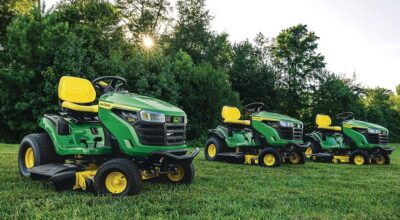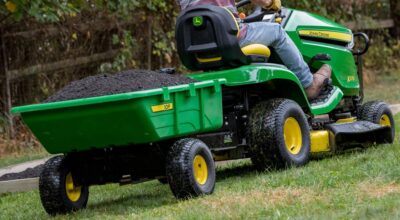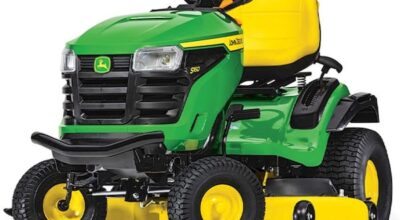As summer comes to an end, homeowners should begin to shift their attention towards what kind of lawn equipment they will need in order to have their yard looking its best. It also brings along the opportunity for individuals to repair damaged lawns and prepare their grass for the seasons to come. With the right lawn equipment and lawn tractor attachments, the experience as a whole can be something that is seemingly much more attainable.
Let’s take a look at equipment, attachments, and tips for how to get your lawn looking its best this autumn.
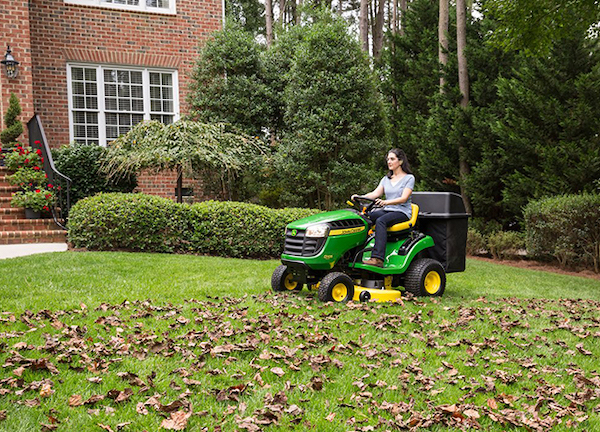
How to Prepare Your Equipment for Fall
As summer comes to an end, you may hear the rev of lawn mower engines slowly start to fade, but that doesn’t mean that you should do the same. Unless there’s snow covering and freezing the land below, there are still many benefits of mowing the lawn. It can help to control incessant weeds, help to recycle nutrients, encourage growth deep into the roots, and can also contribute significantly to overall health and durability of the grass. This being said, it also helps to ensure your yard maintains its aesthetic during snowless seasons.
Here are some tips for making sure your lawn equipment is running properly come autumn:
- Checking Your Mower Blade: You should always be working with a sharp mower blade, no matter what. If you use a dull blade, you run the risk of giving your yard a ragged-looking cut. According to Laurie Trenholm, University of Florida urban turfgrass specialist, this allows more entry points for insects and disease. While insects and disease might be something to consider, clean-cut, healthy grass also has a very nice, aesthetically-pleasing look.
- Installing Your Blade Properly: As mentioned above, you should always check your mower blade before use, however, you should also make sure that the blade is installed properly. When a blade is installed upside down on a mower, it causes the blunt backside of the blade to be used as the cutting edge. This can result in a ragged cut, rendering your lawn prone to insects and disease.
- Know Your Species of Grass: You’ll want to become familiar with your variety of grass before you take your John Deere mowers to it. Finer bladed grasses can be mowed shorter, while wide-leafed species tend to thrive with a little extra height. As mentioned in Laurie Trenholm’s piece, each species of grass thrives at different heights based on its physiology. This is shown in the chart to the right.
- Set the Mower Deck Height: Avoid removing more than one-third of the leaf tissue present in a single mowing. This does not mean mowing solely ⅓ inch of the leaf. For example, if your specific species of grass has an optimal mowing height of 2 inches, the grass would get cut when it is 3 inches in height. It’s best not to allow your grass to grow out and cut it back dramatically – this can stress the grass, causing it to pull nutrients from the root system.
- Plan Ahead for Clippings: Lawn clippings can be extremely beneficial when deposited back onto the lawn. No big clumps of material should be left behind by the mower if you’re staying on top of mowing, so there is no need to remove clippings. Leaves can be mulched and left to feed the soil as well.
https://www.youtube.com/watch?v=Kl_LwHdgXxw
Best Attachments for Fall Lawn Care
It’s crucial for homeowners to turn their attention towards what type of equipment they will need as we move into the fall season— this includes attachments for your John Deere riding mowers. These attachments can help to make your life much easier when it comes to lawn care. Let’s take a look at some of these attachments and how they can help your mowing process.
Rotary Tillers/Hitch Implements
Rotary tillers and hitch implements utilize sets of curved tines with a rotating shaft to dig into your soil. This helps to make sure your soil is fine, as well as clod-free so that planting goes off without a hitch.
While you wouldn’t be planting as many flowers in snowy areas, root vegetables can still be planted and grown, making these attachments useful during all seasons of the year. Whether preparing a seedbed, plowing over the garden or leveling and grading, they can help groomers achieve their desired look. Additionally, they are extremely easy to attach and detach in just a few minutes. Here are some of the more popular models:
- 25-Bushel Frontier Manure Spreader: Manure spreaders are helpful in that they increase efficiency on the farm. They not only distribute manure evenly but also help to provide an even application of the necessary nutrients, while preventing the smothering of grass and reducing any nutrient runoff.
- 60-inch Frontier Landscape Rake (3-Point Hitch): The harder tines of a landscape rake can easily help to dig into the soil, mix compost or mulch into topsoil, or even simply for smoothing out the surface of your area. Due to the small area between the tines, it is also easy to remove stones, branches, and debris from the soil as well.
- 60-inch Frontier Rear Mount Blade (3-Point Hitch): This attachment has multiple uses. In the winter, it can be used for snow removal, and during other seasons of the year, it can be used for the maintenance of soil contours, waterways, drainage ditches and more.
Mulch and Leaf Bagging Kits
Mulching and leaf bagging kits help to make the lawn care experience much less stressful and much more productive. No matter the types of cleanup conditions you may be facing, John Deere has the right solution.
- The 48-inch Leaf Bagging Kit: This kit helps to improve the mower’s vacuum performance to better collect leaves and dry grass.
- 38-inch Mulch Kit: This mulch kit converts a mower so it can be used to mulch grass and leaves.
Tow-Behind Attachments
Tow-behind attachments are perfect for spraying, hauling, thatching, aerating, and more. With an easy dump release and steep angle, John Deere utility carts are designed to haul a variety of materials without obstructing them. Additionally, the 40-inch Thatcherator, available for use with riding lawn tractors, is great for dethatching, aerating, or getting an area prepped for seeding.
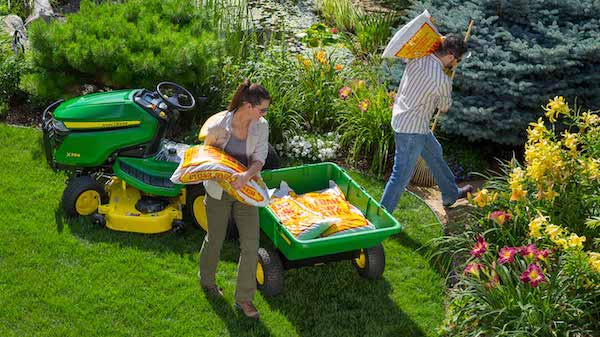
Other Lawn Attachments and Parts
While the aforementioned attachments are a great way to improve your lawn appearance, there are so many others that can also help do the job. Here are a few other parts and attachments that could be especially helpful when tidying up your property this fall.
- John Deere Debris Bag: Adding a debris bag to your mower will help save valuable time because you can continue mowing while picking up debris. It also includes a pocket for a water bottle, bug spray, or whatever else you may need while mowing.
- The Wheel Spacer Kit: This kit can be incorporated to allow the use of tire chains on X729, X739, and X749 John Deere tractors. By implementing spacers, you can increase your machine width by 1.5 inches.
- The Ballast Box: This box offers a way of adding weight to the back of your tractor to help improve traction and stability when using the 45 Loader or front-mounted equipment.
Rejuvenate Your Lawn this Fall
Taking a damaged yard and reviving it back to its former self can be difficult. Where do you start? Find out with these curated steps to the perfect fall lawn:
1. Checking for Signs of Damage
Many of the most common signals of a damaged lawn can be simply observed by using senses. One of the tell-tale signs of damaged or unhealthy grass is the way it feels when walking on it. If the grass feels soft or spongy, that means it’s likely damaged.
On the other hand, if the grass is not taking to watering very well, this could mean the lawn is damaged as well. Here are some of the things to look out for when you think your grass may be damaged:
- Excessive thatch (more than ½ inch) that is constantly appearing in the soil
- Excess weeds such as dandelions or crabgrass
- 20-25% of the lawn bare or covered with these weeds
2. Preparation before Seeding
One thing to consider when preparing your seeding is the power of pH. Knowing the pH of your soil can help you make decisions about what nutrients you need to add, amongst others. When the decision has been made to renovate, a few steps need to be taken before fertilizer and seed should be applied to the soil.
- First, remove any existing weeds and excess thatch in the lawn.
- Then, moisturize the soil with 6-8 inches of water to restore to healthy levels (especially after a long, hot summer).
- Lastly, be sure to properly aerate (3-5 times) to prepare the seedbed.
3. Fertilize the Lawn
Fertilizers should be spread evenly throughout the damaged area in an effort to expedite the establishment and growth rate processes of the emerging lawn. When you get a bag of fertilizer, there are typically three numbers on it. These numbers represent nitrogen, phosphorus, and potassium. All three help lawns to become long, and lush with strong roots.
4. Seed the Lawn
Once the lawn is fertilized, divide the area to be seeded into a few sections to promote different seeding directions. This will help ensure the soil is being hit from various angles. Then, begin seeding in two directions, overlapping halfway through the process. After the seed has been applied, irrigate the lawn to promote soil and seed contact, followed by watering twice a day. Be sure to not over-water – the soil shouldn’t appear to be soggy. This wastes time and money, while also promoting growth for excessive weeds.
5. Mowing
After lush, thick green grass has been established and taken hold (reaching about 3-4 inches in height), begin mowing regularly, as described above, by taking about ⅓ of the length off the top of the grass.
Deere Lawn Equipment for Fall
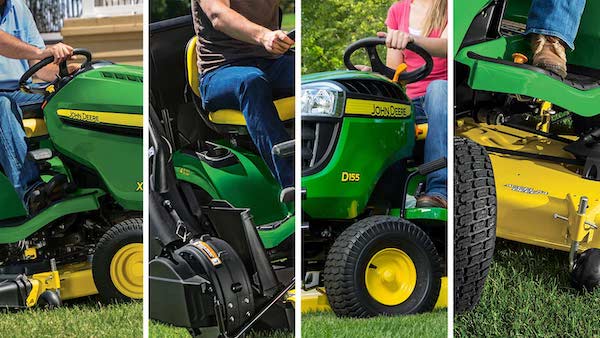
There is a wide variety of lawn tractors to choose from in John Deere’s product line, including the D105, D110, X330, X350, and LA145—all versatile with their own benefits. Which should you choose this fall? Let’s take a look at these different models and the benefits of each.
- D105: The D105 model has a 17.5 horsepower engine with an anti-vibration system and large fuel filter. It utilizes the Edge™ Cutting System with a 12-gauge steel frame, making it very sturdy for difficult jobs. This D105 has an automatic transmission with a single foot pedal, as well as a CargO Mount™ system, and cast-iron front axles.
- D110: The D110 model has a 19 horsepower engine with an anti-vibration system and large fuel filter. This is an increase of about 1.5 from the 105 model. It also uses an Edge™ Cutting System with a 12-gauge steel frame, as well as a CargO Mount™ system and cast-iron front axles—the same as the D105. The transmission is a little different—it’s a Kanzaki® Tuff Torq® hydrostatic transmission that gives operators a wide selection of speeds.
- X330: The X330 model utilizes a 20-hp (14.9-kW) cyclonic V-twin engine, pinion steering system, is made with heavy formed and welded steel material and has exact adjust leveling ports.
- X350: The X350 model has all of the same features as the 330 other than the fact that it uses an 18.5-hp (13.8-kW) iTorque™ power system.
- LA145: One of the most operator-friendly lawn tractors, the LA145 model has a comfortable operator station, and a reverse implement option. It is known for its durability, visibility, and superior cutting performance.
Final Thoughts
As summer comes to a close, it’s necessary to look forward and repair any damage before it’s too late. Fall is the perfect time for that. Get your lawn maintenance equipment out from the back of the garage and reinvigorate your lawn today.
If you have any questions about John Deere lawn equipment, you can contact your local John Deere dealer.
If you enjoyed this post or want to read others, feel free to connect with us on Facebook, Pinterest, or Twitter!
